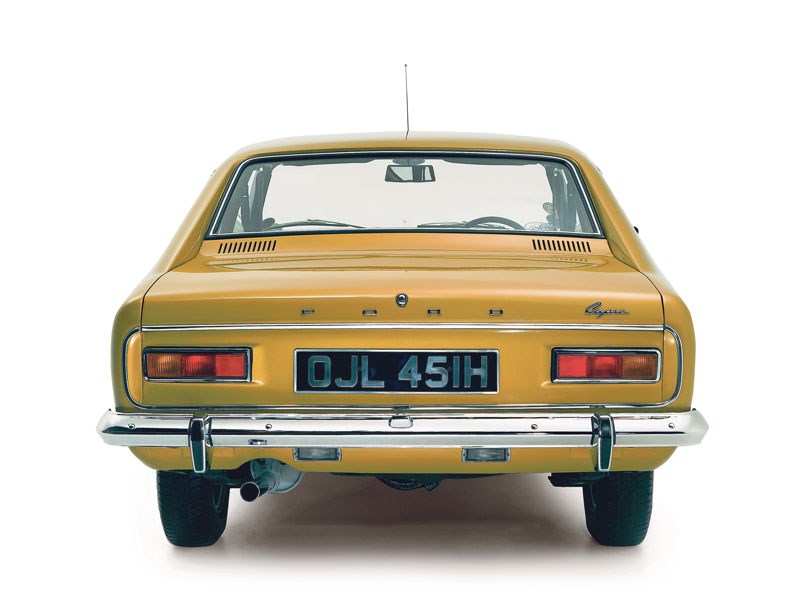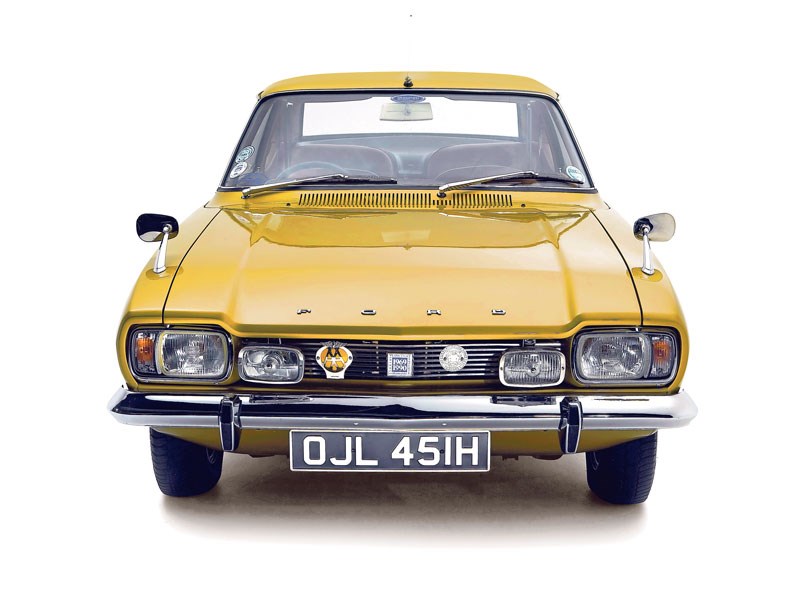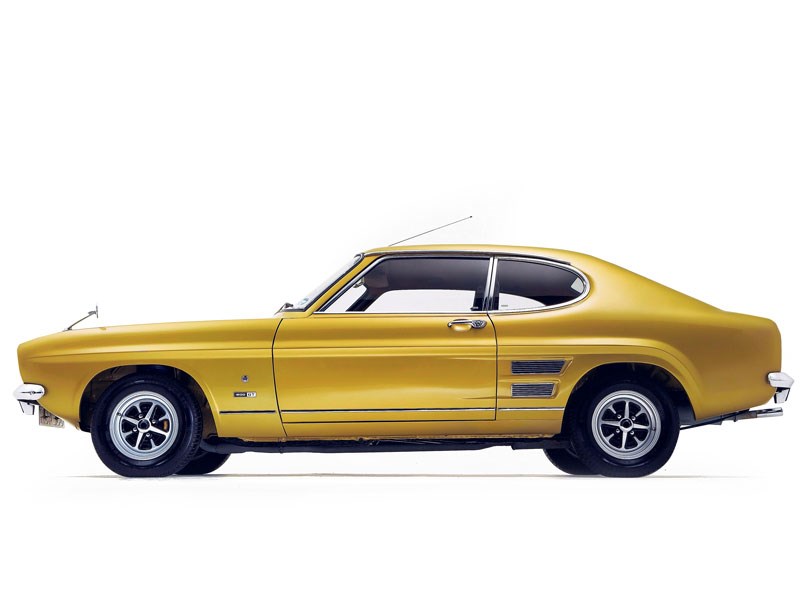The Ford Capri is a true cult classic. This is reflected by the huge volume of parts and accessory dealerships still active, and the sheer volume of active owners clubs. Much of this status is due to the Capri's styling, appearing more American than European – the car had a really bold image. Ford had had such success with the Mustang that it decided Europe needed its own ‘personal coupe’. It followed the same ethos as the Mustang, with cheap prices and lots of scope for personalisation – it appealed to countless people with different budgets.
From appearances in Only Fools And Horses (being Del Boy's sporty, weekend number in a hideous lime green), a starring role in The Professionals (with Bodie and Doyle driving 3.0L versions at break-neck speeds, mostly side-ways), a regular spot on Minder (a Ford Capri was often the car of choice for Terry McCann) to John Wayne jumping Tower Bridge inthe film Brannigan, it was everywhere. Then there's Ford's immortal ad-line when marketing the Capri; "The car you always promised yourself".
In development the Capri was known as the Colt; however Ford were forced to change this as the trademark was held by Mitsubishi. In searching for a new name Ford settled on Capri, which they lent from an earlier, unsuccessful model of theirs, the Ford Consul Capri 335. The first Ford Capri Mk1, was released in 1969 and was basedon the Cortina and produced in the UK at the Dagenham plant.
The Capri was intended to be an affordable car, so the initial range included 1.3L and 1.6L engine derivatives. Although the 1.3L may have seemed underpowered at the time, sales in Britain rose substantially during the mid 1970s.
With the Mk1 Capri having already sold over 400,000 units, 1972 saw the release of the Mk1 facelift, known by some enthusiasts as the Capri 'Bis'. The main changes included were a more comfortable ride, new rectangular headlights and the Kent engines being replaced by Ford Pinto lumps.
Production of the MK 1 Capri stopped in 1974, with the Mark 2 replacing it in January 1974.
VITAL STATISTICS
Ford Capri MKI 1600GT
Engine 1599cc/4-cyl/OHV
Power (bhp@rpm) 93bhp@5400rpm
Torque (lb ft@rpm) 102lb ft@3600rpm
Top speed 100mph
0-60mph 12sec
Consumption 28mpg
WHAT TO LOOK FOR
BODYWORK & CHASSIS
The Capri's construction is so straightforward it’s crude. That’s good news if you want to buy, restore or maintain a Capri, because you can see everything easily and you repair it without difficulty – apart from the poor panel availability. It’s unlikely you’ll find a Mk I Capri that hasn’t seen the welder’s torch, but as long as any work has been done properly, that’s no problem. Putting right somebody’s bodged corrosion repair is bad enough, but if the car has been shunted at any point, the chances are that things won’t line up.
Carefully check all panel gaps – the Capri might not have had especially tight shut lines, but they should at least be even.
The first port of call with the magnet is around the headlamps, followed closely by the trailing edge of each front wing.
Corrosion can be hidden within the outer sills, so don’t expect it to be obvious – if new sills are needed they are £35 per side and fitting/painting them is straightforward. Rear wheel arches and quarter panels rot badly, but repair panels are available for around £30. If somebody else has already done the work, make sure the outer panel is attached to the inner – bodges are common.
The best way of making sure that everything is what it seems, is to press hard on the sills to see if there’s any give. If the interior is a bit tatty, you can probably lift the carpet enough to press from the inside as well – if the car is really rotten this should give the game away. The front windscreen rubber is prone to leak at the offside lower corner, allowing water to penetrate the windscreen pillar, A-post, sills and footwell – damage may be done before a leak here is noticed.
While you’ve got the doors open, take a look along the underside – they often corrode from the inside out. The A-posts also rust badly, so make sure they’re not flexing as the door is opened – because the doors are long they’re also quite heavy. Their weight is enough to cause wear in the hinge pins. Hinge pins are available for just a few pounds – try Ford to track one down. A check on the front valance is also a good idea as they hold the water and rot badly at the point where they join the wings.
It’s time to lift the bonnet to check those MacPherson strut tops. Thankfully they’re not as rot-prone on the Capri as most other Fords. If the plates have been replaced they should be smoothed in (except on 3-litre cars) and if they are original the production ID number will be visible as it was pressed into the wing top here. The inside edges of the bonnet also rot away if left, so ensure the metal is sound all round the panel – you’d be lucky to track down a replacement bonnet.
ENGINE
The least desirable Capri – as well as the rarest and most highly stressed – is the 1300. Using the same Kent engine but with a few more nags available is the 1600 which, like the 1300, was also available in GT form– this meant twin-choke Webers and four-branch manifolds with consequent power gains. The first sign of trouble will be noisy valve gear, normally down to worn rockers, cam followers and the camshaft itself – by that stage the engine needs a top-end rebuild.
Worn timing chains also cause problems – listen for rattle from the front of the engine – but compared with all these potential maladies, it’s worn rings and bores that will blow the biggest hole in your wallet. Fumes from the oil filler cap and blue smoke from the exhaust will give the game away – a bottom end rebuild lies in store.
The Kent engine is very easy to work on and a rebuilt unit can be tracked down for around £600. Alongside the Kent unit sat the V4 engine of the 2.0-litre cars.
Whereas the Kent cars were disliked because of their lacklustre performance, the V4 cars were shunned due to poor reliability.
The oil pump drive can fail without warning, scrapping the engine in the process; the fibre timing gear can also break up, with much the same result. Steel timing gear can be fitted instead, at around £60 for the parts.
Another common V4 malady is worn bearings for the balancer shaft, which helps to reduce engine-generated vibration. Without this shaft the V4 is a harsh unit, but once the shaft’s bearings go it’s even harsher, so it’s easy to tell if new parts are needed just by starting the engine up. While you’ve got the bonnet up, check for oil and water leaks from blown head gaskets. Fixing those isn’t tricky or expensive, but if the bottom end is rumbling or the valve gear is noisy, steer clear. Parts for the V4 power plant are the hardest to source – go for a car with a more common engine.
Capris with the Essex V6 engine are the most sought after, despite the V6 being based on the same design as the V4. It didn’t need a balancer shaft, which helps things enormously and it’s far less stressed – but the oil pump drive can still pack up with no warning and the fibre timing wheel can still disintegrate. The V6 also has a tendency to overheat, especially if the radiator has been allowed to get clogged up with silt. Blown head gaskets and even cracked cylinder heads are symptoms to look out for so check for oil and water leaks in the engine bay along with white emulsion on the underside of the filler cap.
The final engine fitted to the Mk I Capri is the Pinto (replacing the Kent unit in September 1972). True to Ford, this powerplant had a built-in self-destruct feature: it had a habit of eating camshafts because of a lack of lubrication. The problem was a spraybar fitted under the rocker cover, which was supposed to squirt oil onto the camshaft lobes. But the smallest bit of dirt would block it up. Sometimes it took just a few thousand miles before the camshaft ran dry. The spraybar’s design was revised years ago, which helps things, and as long as the oil and filter have been changed regularly, all should be well. If in doubt a new spraybar can be fitted – it’s not difficult and a new part costs under a fiver. If a new camshaft is needed, the work is easy enough to do but parts for the Pinto engine are more expensive than for the other Ford powerplants.
Capris with the Essex V6 engine are the most sought after, despite the V6 being based on the same design as the V4. It didn’t need a balancer shaft, which helps things enormously and it’s far less stressed – but the oil pump drive can still pack up with no warning. It’s worth looking out for any tuning that’s taken place. There are plenty of reputable companies selling bits to upgrade Ford engines, but there are also lots of cheap parts around that tend to reduce power instead. Bigger carbs and hotter camshafts are par for the course, but gas-flowed heads and free-flow air filters are also common along with supposedly more free-breathing exhaust systems. All these need to be checked and if somebody has taken the usual downdraught Weber route to up the power, make sure it’s all set up properly. It often isn’t.
ELECTRICS
The electrical system is generally reliable. If the loom does need some TLC you’ll have to get the original one rebuilt, as the special connectors that Ford used are no longer available. When it comes to new instrumentation and switchgear, you’ve had it. It’s very rare to find anything at auto jumbles, but luckily, what was fitted is pretty reliable.
Sometimes the headlight switch can get too hot because there’s no relay, so if you want to preserve the life of the unit, slot a relay into the circuit.
Make sure the lights are in good condition, because they’re notoriously pricey to replace, and in the case of the headlights, hard to track down. Pre-facelift cars were fitted with the same headlamps as an Allegro, and you’ll pay £85 for a new one.
Later Capris were fitted with headlights which are even harder to find, and if you can source one you’ll have to fork out over £100 for it – make sure you don’t buy a European import, as they dip the wrong way. Rear lights aren’t any better – early Capris used Escort units which crop up occasionally at around £100 each. But light units for post-facelift cars are extremely rare now and cost even more if they do materialise.
RUNNING GEAR
All Capris were fitted with rack and pinion steering, which doesn’t give problems other than the usual worn parts such as track-rod ends and split gaiters. There’s also a flexible joint in the steering column, and this can wear – if it does, the steering will be vague and suffer from shake. The knuckle has a leather cover which is riveted onto the arm – if you’re struggling to find a new one, a Mk III one will fit.
The suspension is also pretty straightforward, with MacPherson struts at the front that may leak, but they're usually reliable.
Make sure any test drive takes the car over bumpy roads and listen for knocks from worn bushes in the strut top or the track control arms. If these latter bushes have had it, your best bet is to fit new arms rather than renewing the bushes. A new pair of track control arms costs £45 and they’ll come with new bushes already.
The Capri’s rear suspension is also pretty straightforward, with leaf springs that sag after a while (£125 to replace) and shock absorbers that leak. Fixing either set up is easy enough and if the rear dampers need renewing you shouldn’t need to spend more than £35 on a new pair. Cars built before September 1972 were equipped with twin radius arms to keep the back axle in place while later cars were fitted with a single-piece anti-roll bar instead. Whichever system, there’s a good chance the bushes will have seen better days – but at least new bushes are cheap and easy to replace.
One of the great things about the Capri is its transmission, with a slick gear change and strong final drive. The synchromesh is tough and unless the engine has been really highly tuned, the transmission will cope quite happily with plenty of power and torque. Any Capri transmission will take 100,000 miles if looked after and at this mileage the worst that’s likely to materialise is worn synchromesh on second gear and vocal gearbox bearings. Accelerate hard in each gear and see if the car jumps out of gear. If it does, the gearbox has had it and you can bank on having to spend around £250 on a replacement unit. Try to pull away in second gear and see if there’s any judder. If there is, there’s either oil on the clutch or there are weak engine/gearbox mounts. If there’s a whirring noise when you press the clutch down, the clutch release bearing’s had it.
There aren’t many automatic Capris around. The transmission doesn’t have any inherent problems, but still check the transmission fluid, which should be red, although if it’s brown that’s okay. Black means trouble ahead.
Check the fluid by parking the car on a level surface and running the engine until it reaches normal running temperature. Select ‘P’ and allow the car to idle for two minutes, then with the car still idling remove the dipstick and check the level. The difference between the low and full marks is one imperial pint. Also make sure it’s not hanging onto the gears for too long. Automatic gearboxes can be reconditioned for around £150.
Diffs don’t usually give any problems until at least 100,000 miles. The first sign of impending expense is whining. If it does need renewing, a new unit typically costs around £200 on an exchange basis. Also listen for clonks from worn universal joints. They’re cheap to replace, but the job’s fiddly.
If there’s a whine and steering wheel shake at some speeds, it’s likely to be worn half-shaft bearings which cost around £20 per side to replace. If the diff is the problem this is more difficult as the early Timken axle needs special tools to line it up. So it’s really a job best left to the experts.
BRAKES
Aftermarket wheels with extra wide tyres are a common fitment – fine if they fit properly. Make sure there are no clearance problems and if the car looks overtyred, be especially wary of worn suspension and brakes that have been given a hard time.
The self-adjusting mechanisms fitted to all Capris can seize up if the car hasn’t been maintained properly or has been left standing for long periods. But they’re not inherently unreliable so they should be trouble-free. All Capris were fitted with disc brakes at the front, but the brakes aren't up to the job on V6 models – do be careful on the test drive. Servo assist was an option on all cars below a 1600 GT; above that it was standard.
Capris fitted with an automatic gearbox had larger pads and shoes, so if the brakes are due for a service and the car has a slushbox, make sure you don’t try to fit a braking kit for a manual car.
INTERIOR
New interior trim is the Holy Grail of the Mk I Capri owner – even used stuff in good condition is pretty much impossible to find. The only real answer is to get stuff retrimmed. Seats sag and the stitching comes apart, so getting a decent trimmer is the best thing to do. Interior panels will also need to be refurbished (not easy) and the same goes for the dash surround – which can be retrimmed, but it’s tricky as so much work is required.
The original carpets were moulded to fit the shape of the floorpan – nowadays any new floor coverings will be made from flat carpet so won’t fit as well.
It’s the same story for exterior trim, with bright work rarely for sale. Badges get lost or discoloured but most are replaceable for about £15 each. Original chrome wiper arms may be a problem and bumpers rarely turn up. When they do they’re over £100 but be aware that the early Mk I only had one number plate light aperture in the bumper – look closely as bumpers for sale may have two.
OUR VERDICT
When the Mk I Capri was current, there was a model to suit every pocket. But nowadays there simply aren’t enough to go round and you may not be able to find your first choice of spec.
Whereas it used to be the Mk III that everybody wanted, it’s the earliest cars which are now in favour. There’s no sign of that trend changing, so if you’ve been hankering after a Capri for a while, now is the time to start tracking a good one down.
You can make life easier by joining the Capri Mk I Register, but there are still relatively few cars out there, so you can’t be too choosy.


